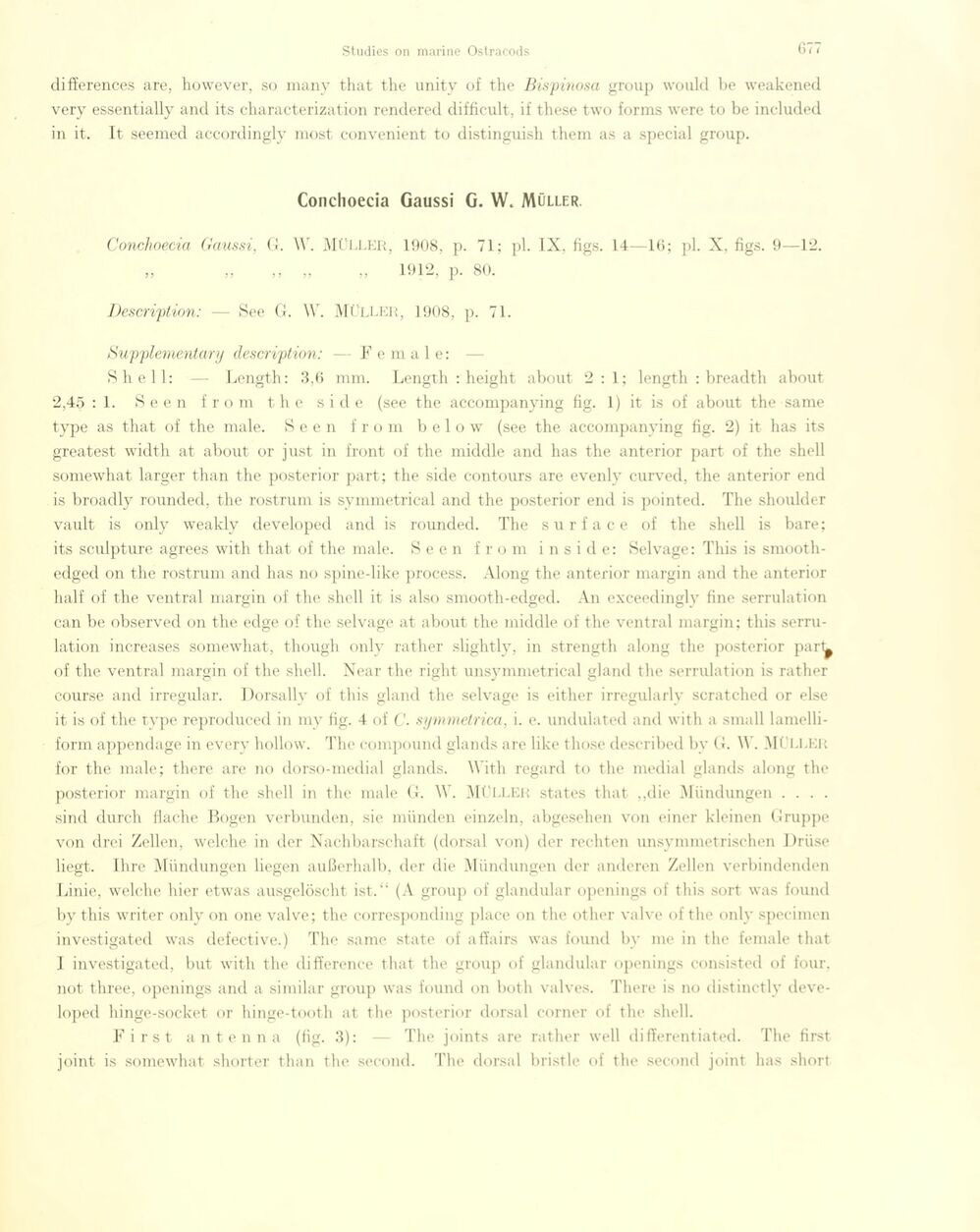
Full resolution (JPEG) - On this page / på denna sida - Sidor ...

<< prev. page << föreg. sida << >> nästa sida >> next page >>
Below is the raw OCR text
from the above scanned image.
Do you see an error? Proofread the page now!
Här nedan syns maskintolkade texten från faksimilbilden ovan.
Ser du något fel? Korrekturläs sidan nu!
This page has never been proofread. / Denna sida har aldrig korrekturlästs.
differences are, however, so niany that the unity of the Bispinosa group would be weakened
very essentially and its characterization rendered difficult, if these two forms were to be included
in it. It seemed accordingly most convenient to distingiiish them as a special group.
Conchoecia Gaussi G. W. Müller
Conchoecia Gaussi, G. W. MULLER, 1908, p. 71: pi. IX, figs. 14—16; pi. X, figs. 9—12.
„ „ „ „ 1912, p. 80.
Description: — See G. W. MÜLLER, 1908, p. 71.
Supplementary description: — Female:
Shell: — Length: 3,6 mm. Length : height about 2:1; length : breadth about
2,45 : 1. Seen from the side (see the accompanying fig. 1) it is of about the same
type as that of the male. S e e n f r o m b e 1 o w (see the accompanying fig. 2) it lias its
greatest width at about or just in front of the middle and has the anterior part of the shell
somewhat larger than the posterior part; the side contours are evenly curved, the anterior end
is broadly rounded, the rostrum is symmetrical and the posterior end is pointed. The shoulder
vault is only wealdy developed and is rounded. The surface of the shell is bare;
its sculpture agrees with that of the male. Seen from inside: Selvage: This is
smooth-edged on the rostrum and has no spine-like process. Along the anterior margin and the anterior
half of the ventral margin of the shell it is also smooth-edged. An exceedingly fine serrulation
can be observed on the edge of the selvage at about the middle of the ventral margin; this
serrulation increases somewhat, though only rather slightly, in strength along the posterior paru
of the ventral margin of the shell. Near the right unsymmetrical giand the serrulation is rather
course and irregulär. Dorsally of this giand the selvage is eitlier irregulari y scratched or else
it is of the type reproduced in my fig. 4 of C. symmetrica, i. e. undulated and with a small
lamelli-form appendage in every hollow. The compound glands are like those described by G. W. MULLER
for the male; there are no dorso-medial glands. With regard to the médial glands along the
posterior margin of the shell in the male G. W. Müller states that „die Mündungen ....
sind durch flache Bogen verbunden, sie münden einzeln, abgesehen von einer kleinen Gruppe
von drei Zellen, welche in der Nachbarschaft (dorsal von) der rechten unsymmetrischen Drüse
liegt. Ihre Mündungen liegen außerhalb, der die Mündungen der anderen Zellen verbindenden
Linie, welche hier etwas ausgelöscht ist.“ (A group of glandular openings of this sort was fourni
by this writer only on one valve; the corresponding place on the other valve of the only specimen
investigated was defective.) The same state of affairs was found by me in the female that
I investigated, but with the difference that the group of glandular openings consisted of fom-,
not three, openings and a similar group was found on both valves. There is no distinctlv
developed hinge-socket or hinge-tooth at the posterior dorsal corner of the shell.
First antenna (fig. 3): — The joints are rather well differentiated. The first
joint is somewhat shorter than the second. The dorsal bristle of the second joint lias short
<< prev. page << föreg. sida << >> nästa sida >> next page >>